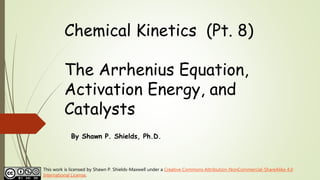Chem 2 - Chemical Kinetics VIII: The Arrhenius Equation, Activation Energy, and Catalysts
This document discusses chemical kinetics and the factors that affect reaction rates. It introduces the Arrhenius equation, which relates the rate constant k to temperature, activation energy Ea, and other parameters. Raising the temperature increases the reaction rate by providing more energy to molecules during collisions. Catalysts also increase the reaction rate by lowering the activation energy barrier, changing the reaction mechanism to require less energy. The activation energy is the minimum energy required for molecules to react during collisions. Graphing the Arrhenius equation can determine a reaction's activation energy from experimental data. Catalysts increase the reaction rate without being used up in the reaction or changing its thermodynamics.

Recommended
Recommended
More Related Content
What's hot
What's hot (20)
Viewers also liked
Viewers also liked (20)
Similar to Chem 2 - Chemical Kinetics VIII: The Arrhenius Equation, Activation Energy, and Catalysts
Similar to Chem 2 - Chemical Kinetics VIII: The Arrhenius Equation, Activation Energy, and Catalysts (20)
More from Lumen Learning
More from Lumen Learning (20)
Recently uploaded
Recently uploaded (20)
Chem 2 - Chemical Kinetics VIII: The Arrhenius Equation, Activation Energy, and Catalysts
- 1. Chemical Kinetics (Pt. 8) The Arrhenius Equation, Activation Energy, and Catalysts By Shawn P. Shields, Ph.D. This work is licensed by Shawn P. Shields-Maxwell under a Creative Commons Attribution-NonCommercial-ShareAlike 4.0 International License.
- 2. Reaction Rates and Temperature The rate of a reaction generally goes up with increasing temperature. The rate constant k is temperature dependent. Why?
- 3. Factors Affecting Reaction Rates The overall reaction rate depends on: The frequency of collisions The fraction of collisions with enough energy to react The orientation of colliding molecules (steric factor)
- 4. The Arrhenius Equation Molecules only react if they collide with each other in the correct orientation. Increasing the temperature increases the energy and frequency of molecular collisions. The Arrhenius equation relates the rate constant k to all of these factors.
- 5. The Arrhenius Equation 𝒌 = 𝐀𝐞 −𝐄 𝐚 𝐑𝐓 k is the rate constant Ea is the activation energy (to be discussed) “A” is the pre-exponential factor representing the likelihood that collisions with the proper orientation occur. R is the gas constant (8.314 J/mol K) T is the temperature in Kelvin
- 6. The Arrhenius Equation and the Rate Law For the elementary reaction: D + B C The rate law is: Rate = k[D][B] Plug in the Arrhenius equation to visualize its effect on the rate of reaction: 𝐑𝐚𝐭𝐞 = 𝐀𝐞 −𝐄 𝐚 𝐑𝐓 𝐃 𝐁𝒌 = 𝐀𝐞 −𝐄 𝐚 𝐑𝐓
- 7. Activation Energy, Ea The macroscopic reaction rate is determined by the frequency of collisions having sufficient energy to overcome the activation energy barrier (subtracting those that do not have the correct orientation to react (steric factor)). Molecules need to have enough kinetic energy to overcome bonding and repulsions of the reactants. This required minimum amount of energy is called the activation energy Ea
- 8. Temperature and Activation Energy Only a small percentage of collisions have enough energy to react. This proportion increases with increasing temperature. Fraction of molecules with energy E Energy Activation Energy Ea Fraction of molecules greater than Ea (enough E to react) Low T High T
- 9. Finding Ea by Graphing 𝒌 = 𝐀𝐞 −𝐄 𝐚 𝐑𝐓 Take the natural log (ln) of both sides 𝐥𝐧 𝒌 = −𝐄 𝐚 𝐑𝐓 + 𝐥𝐧 𝐀 Plot ln k vs 1/T to determine the activation energy.
- 10. Finding Ea by Graphing 𝐥𝐧 𝒌 = −𝐄 𝐚 𝐑𝐓 + 𝐥𝐧 𝐀
- 11. Finding Ea by Graphing 𝐥𝐧 𝒌 = −𝐄 𝐚 𝐑𝐓 + 𝐥𝐧 𝐀 Reactions with a larger Ea show a higher sensitivity of the rate constant k to the temperature.
- 12. Arrhenius Equation Another useful form of the equation relates the rate constant k at two temperatures ln 𝑘2 𝑘1 = − Ea R 1 T2 − 1 T1 Where k1 is the rate constant at T1, and k2 is the rate constant at T2
- 13. Reaction Progress and Activation Energy Exothermic Reaction Endothermic Reaction
- 14. Increasing the Rate Constant k There are two ways to increase the rate constant for a given reaction: raise the temperature use a catalyst to lower the activation energy Ea Catalysts change the reaction mechanism in such a way as to decrease the activation energy Ea.
- 15. Catalysts Lower Ea 𝐥𝐧 𝒌 = −𝐄 𝐚 𝐑𝐓 + 𝐥𝐧 𝐀 Catalysts essentially increase the number of molecules with the required activation energy to react by lowering the requirement.
- 16. Another View: Catalysts Lower Ea Instead of increasing the temperature, use a catalyst to lower the energy barrier to reaction. Catalysts change the reaction mechanism.
- 17. Catalysts Catalysts do not change the thermodynamics of the reaction (i.e., they do not change the position of equilibrium). More on that later… Catalysts are not used up or produced in a reaction. They can be used in less than “stoichiometric quantities” (or very small amounts). They can be homogeneous (same phase) or heterogeneous (alternate phase) catalysts.
- 18. Example Problems will be posted separately.
